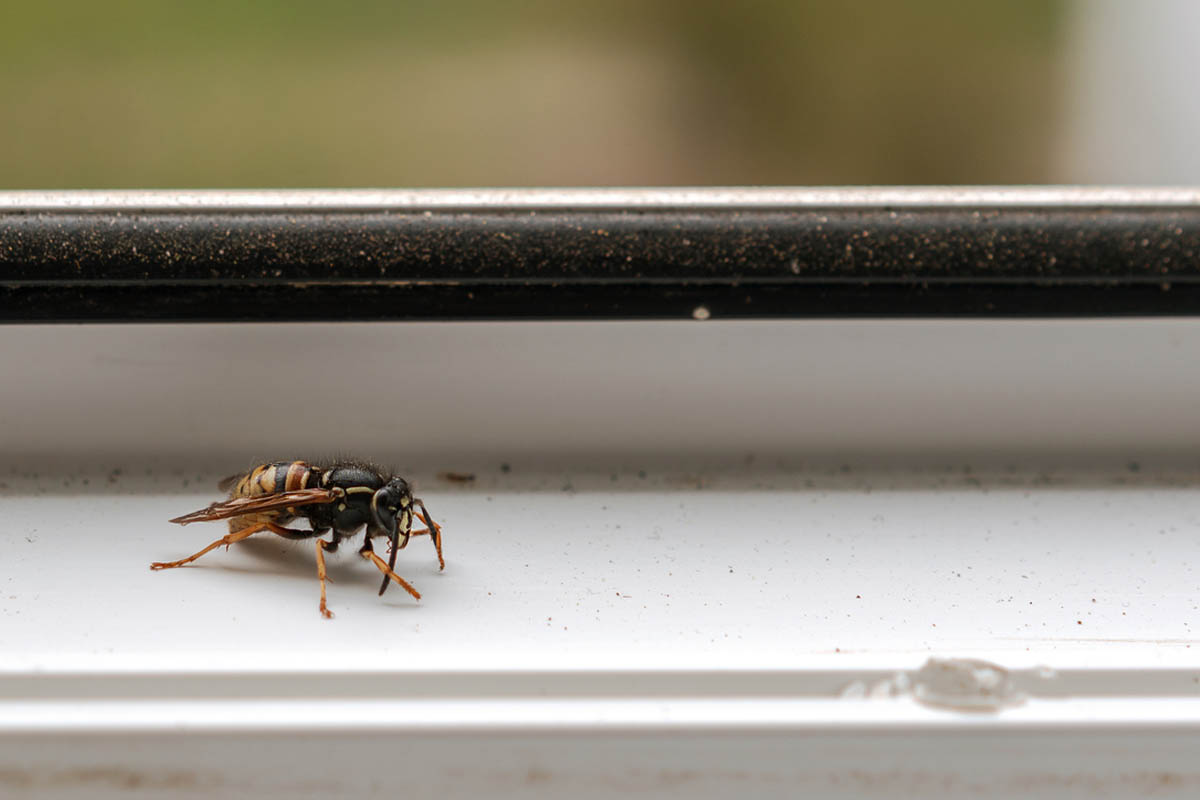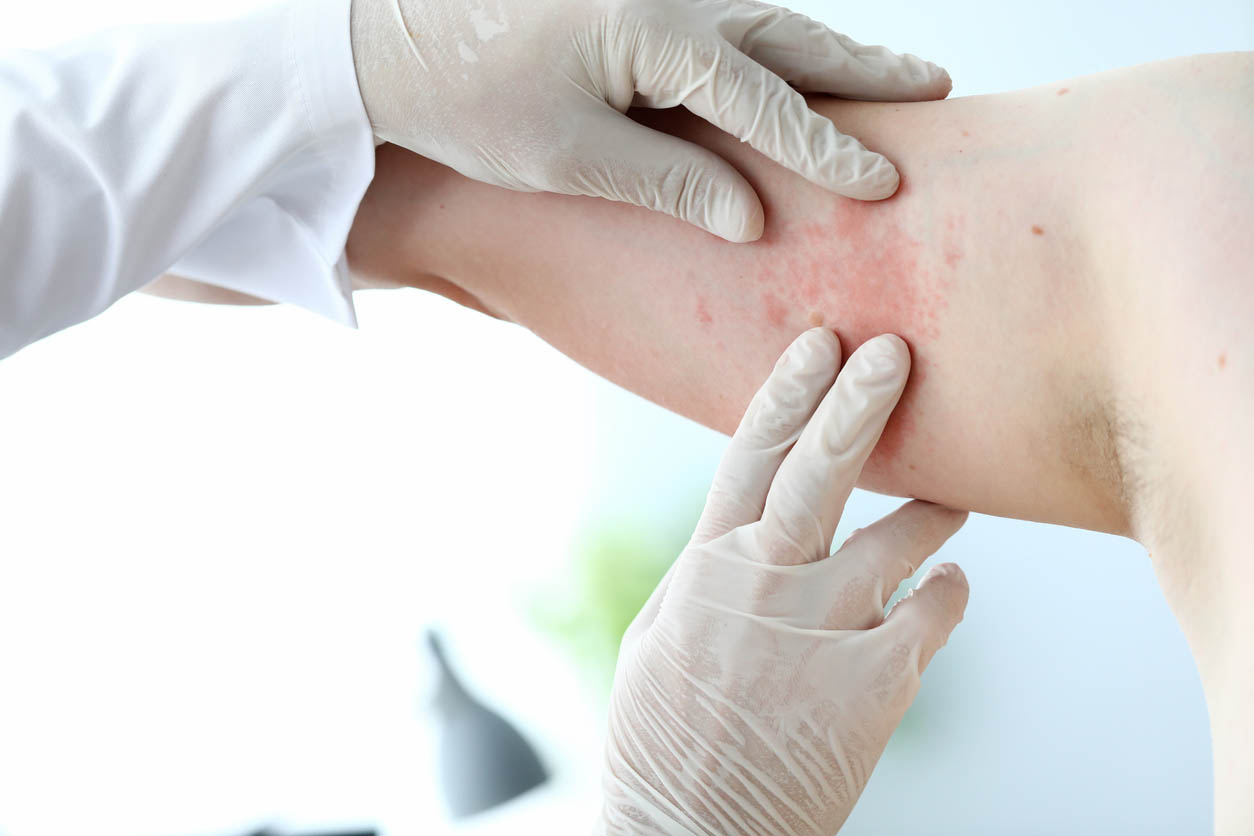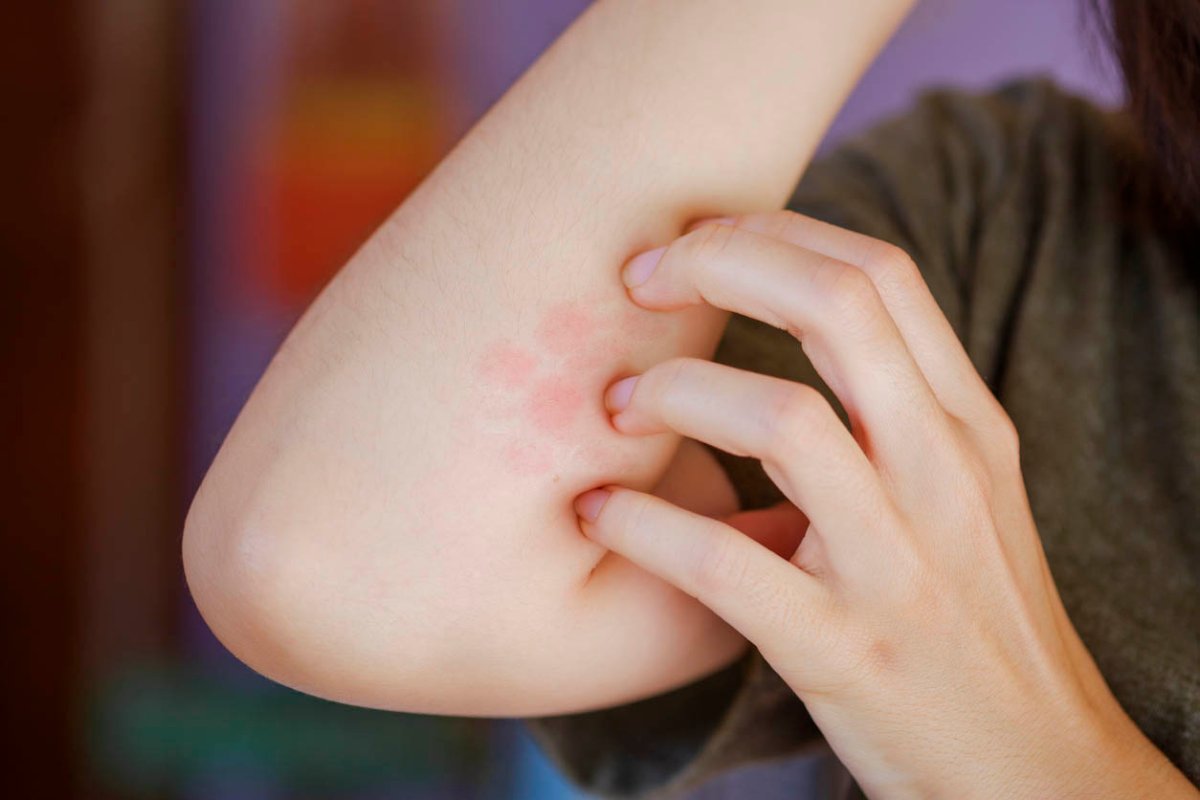We may earn revenue from the products available on this page and participate in affiliate programs. Learn More ›
What You Need to Know
- Bug bites don’t always show up right away—in some cases, they won’t be noticeable for up to 2 weeks.
- Some common biting and stinging pests that could be to blame for mysterious bites or rashes are bed bugs, chiggers, black widow spiders, mosquitoes, brown recluse spiders, ticks, kissing bugs, fleas, bees, deerflies, ants, and scorpions.
- Sometimes rashes or hives caused by allergic reactions or medical conditions can be mistaken for bug bites, which may explain the appearance of bites with no sign of bugs.
- A pest control professional can inspect the home for pests to determine the source of the bites, and treat the home if necessary.
Q: I have itchy, red bites but no signs of bugs in my home. Honestly, I’m not sure if they’re a rash or bites. How can I find out what’s biting me?
A: Bug bites and rashes of any kind are no fun, and sometimes they’re even harmful to your health if you end up with an allergic reaction. Most bug bites that blister are easier to identify, but some could almost look like a rash. Household insects are adept at hiding invisibly sometimes, making it frustrating to determine precisely what kind of bug is biting you. Common insect bites or stings come from bugs like chiggers, bees, spiders, fleas, bed bugs, mosquitoes, kissing bugs, and more. In most cases, bug bites are not deadly to humans, but some bites can cause long-term illnesses, extreme discomfort, or allergic reactions that may require a doctor visit. If your bug bite rash almost looks like hives, it’s likely that the culprit is bed bugs. These insects can be hard to spot since they are tiny and hide in itty-bitty cracks and crevices. Here, we’ll break down what could be causing your itchy woes.
[homeadvisor heading=”Think bugs are the source of your bites?” subheading=”A pro can confirm. Get free, no-commitment estimates from top-rated exterminators near you.” action_text=”Find a Pro”]
Closely inspect your home for the presence of bed bugs.
Bed bug bites can show up the next day or even up to 2 weeks later, though you’ll usually see them within 3 days. You’ll see straight lines of red bites, usually in clusters of three or more. These raised bites become itchy and inflamed for several days due to a mild allergic reaction from the bugs’ saliva that’s left behind. If you’ve compared your bites to bed bug bites images and they seem like a match, then you need to find out where the nasty culprits are hiding. Using a bright light and perhaps even a magnifying glass will help you spot these tiny reddish-brown bugs.
Despite the name, bed bugs don’t necessarily only live in beds. They can be found in the holes of a power outlet, a chair or couch, cracks in a wall or baseboard, or dressers where there are a lot of nooks and crannies for tiny insects to hide. Any small space where a bed bug could find shelter can be a hiding place—even behind the head of a screw.
The easiest way to identify the presence of bed bugs in your bed is to look for the telltale trails they often leave behind on your sheets or mattress. Inspect your sheets and along the edges of your mattress carefully to see if there are almost microscopic black trails of feces or faint red dots. These red dots are blood, and they can be larger dots if you happen to roll over a well-fed bed bug in the night and squish it. If you were bitten on your face, neck, arms, hands, or feet, then check those corresponding areas of the bed for signs of feces or blood.
Next, you’ll need to inspect the edges of your mattress where the seams are. It’s the perfect place for bed bugs or their tiny white eggs to hide. Make sure to have a bright light on as you work. They also prefer to live under the mattress or in the box spring. Inspect all the edges thoroughly to find where they’re hiding.
It’s possible to miss where bed bugs are hiding on your bed, but an infestation around an outlet or along a baseboard may be easier to spot. However, if you aren’t successful at a visual inspection, you can try using interception devices specifically made to catch bed bugs or other bugs attracted to your bed. Simply place them right under the legs, bed, or chair where you’re trying to catch the bugs. Once the bugs fall in, they can’t get out, and you’ll be able to identify where the primary infestation is likely located.
Another somewhat effective option is using a standard insect glue trap in the area you suspect is infested. When the bugs walk on it, they’ll be trapped so you can identify them. Alternatively, you can use a mattress encasement that’s specifically made to either trap existing bugs inside or make it easier to identify them when they’ve crawled on it. They’re an effective prevention and detection method.
The most convenient method is to hire a pest control professional to come to your house and inspect your bedroom for signs of any insect infestation. Make sure the company lists bed bugs as one of its specialties. They’ll know exactly how to find a nest of bed bugs and eliminate them, and they might even help identify the kind of bug bites you have.

Other biting insects could be hiding in your home.
Bed bugs aren’t the only things that bite humans. Part of bug bite identification is knowing which insects live in your region. This is helpful for detecting a spider bite rash or identifying chigger bites (chiggers are another form of mites). Looking up bug bite pictures on the internet can help you compare against your bites. Here are many of the most common biting insects that could also be the culprit if you don’t think it’s bed bugs.
- Chiggers or mites also leave severely itchy welts that can look like a rash without a distinct pattern. A female chigger could also lay eggs in the skin, which can lead to a scabies infection. Chiggers and mites are more common in the southern, southeastern, and midwestern U.S., where the weather is more humid and warm.
- Black widow spiders can be found almost anywhere, but especially in the western and southern United States. These are considered some of the most venomous spiders, yet they are rarely lethal to humans. A bite from a black widow has two puncture wounds, as opposed to the usual one puncture, and it’s immediately painful, becoming worse later on. Severe reactions may include difficulty breathing, excessive sweating, muscle rigidity, and severe abdominal cramping. In this case, seek medical assistance, but for children or the elderly, seek medical assistance as soon as a bite is detected.
- Mosquito bites are common in most areas of the country. They rarely occur in a pattern, but they are also itchy and red or pink with a small or large bump. Most bites aren’t serious unless an allergic reaction occurs or if the mosquito carries a disease such as Zika, West Nile virus, malaria, or eastern equine encephalitis.
- Brown recluse spider bites are usually a sharp sting that becomes painful later on. The bite area will start to look bruised before becoming crusty and dark. It’s imperative that a suspected brown recluse bite gets medical attention, as it could lead to serious health problems like kidney failure and coma. Brown recluse spiders are usually found in midwestern and southern states.
- Ticks are known to bite and burrow their heads into the skin. Removing them completely can be challenging and is best done by a medical professional. These insects often carry Lyme disease, which can become a debilitating illness. A sure sign of a tick bite is a bull’s-eye ring around a red, inflamed bump. Ticks can be found in most areas of the country, but especially the southern and eastern regions.
- Kissing bugs, or assassin bugs, are also known to leave red, infected bites. Most often, these bites occur on a person’s face. Occasionally, an infected bite from the insect’s feces can result in Chagas disease, which feels like a severe flu. In about 30 percent of these cases, people have been known to develop heart problems later on.
- Fleas can bite humans and leave tiny red bumps in clusters of three or four—not in a line like bed bugs. These bites usually occur around feet, ankles, armpits, waist, or in the bends of elbows or knees. Cases of the plague are rare after being bitten by fleas, but fleas can cause irritating skin rashes.
- Bee stings are sharp when they happen, but they fade to a dull ache. The affected area will feel hot and itchy and look red with a white ring around it. The biggest concern with bee stings is that many people (and animals) have a severe allergic reaction. The area might swell severely, or it could cause anaphylactic shock. Hornet stings are similar to bee stings. Wasps are also known to bite humans. It’s a painful sting at first that lingers as a dull ache, but the same concerns for an allergic reaction exist. Seek medical attention immediately if an allergic reaction occurs.
- Deerflies or horseflies usually pay more attention to their namesakes for sustenance, but they are known to bite humans as well.Bites are intensely sharp and painful when they happen, and they can cause bleeding, swelling, or an allergic reaction. Black flies might also bite humans around the eyes, ears, and scalp, leaving a numbness, swelling, or soreness for a few days. These flies don’t generally carry diseases, but it’s still wise to use bug repellent or wear long clothing in an infested area.
- There are many species of ants, and some of them are venomous. Carpenter ants spit formic acid into a bite, causing an intense burning sensation. Fire ants are one of the most common venomous ants. They will bite, hold on, and sting, which makes a burning, stinging sensation. If fire ants bite you, the bites will probably show up a day or two later as white, fluid-filled pustules that could also be red and itchy. It’s important not to scratch one of these pustules to bursting, as this significantly increases the risk of infection.
- Scorpions are considered an arachnid, like spiders. These larger pests can pose serious health risks as well if the sting causes an allergic reaction. When a scorpion attacks, its stinger injects poison, causing an intense burning pain that spreads. If you’ve been stung by a scorpion and begin to experience vision or muscle control problems, seek medical attention immediately. Scorpions are typically found in the southwest deserts and even up to some midwestern states.
Household products or environmental irritants could cause hives or rashes.
If no pests can be found and the irritation doesn’t seem to match any of the most common bug bite pictures, you may be experiencing a skin reaction to a household product or environmental irritant. Consider the location of the rash. If it’s on the hands and arms, think about what you’ve come in contact with recently. Perhaps a new task at work puts you in contact with a new cleaning supply, chemical, or other substance. A laundry detergent or soap could cause irritations where clothing fits snugly. Other common irritants could be cosmetics, hair products, perfume, paper, fire-retardant clothing, or animals.
The cause could also be environmental, which means things that come in contact with you passively. People who work near the fine fibers and dust made around shredded paper or cardboard can develop skin irritations as the fibers adhere to the skin and cause a prickling sensation that develops into a rash. Old drapes can also release fabric fibers that do the same thing. Additionally, fibers from ceiling tiles or insulation can get circulated around, especially during construction. Some air pollutants can also cause a rash, though headaches and throat irritation are more common. Examples of air pollutants can include ammonia-based cleaners, tobacco smoke, formaldehyde, and other chemicals.
A trip to a dermatologist or industrial hygienist can help identify what’s causing the problem if you’ve ruled out bug bites. The sooner you book an appointment, the sooner you can identify a way to treat the existing irritations and prevent future ones.
Certain medical conditions could be causing skin conditions that resemble bites.
It’s possible that the skin irritation isn’t a bug bite at all. There are several other causes of irritated skin that could be the problem. Hives are usually the reason for an unexplained rash of red or purple itchy bumps that resemble mosquito bites. If you push on these bumps, they typically turn white. Hives are a common occurrence that can happen as a reaction to allergies like seafood, nuts, insects, pollen, latex, or even some medications. You’ll need to visit a dermatologist to determine if the bumps are hives or not and whether you need medications stronger than over-the-counter drugs.
Similar to hives, the bumps could be caused by contact dermatitis, which is basically a skin reaction to coming into contact with something you’re allergic to. Reactions show up in 1 to 2 days and can last 2 to 3 weeks. Otherwise, the culprit could be eczema, which causes itchy, red skin that can form bumps. Over time, skin becomes dry, thick, and flaky and might even change color. Scratching eczema makes it worse, so you’ll need to speak with a dermatologist to determine the best course of action for relief.
Stress has also been known to induce the need to scratch intensely, just as some diseases like kidney disease, diabetes, or thyroid problems. Severe itching in a late-term pregnancy is also common, though it sometimes reflects a different condition called cholestasis that needs immediate attention as well.
Fungal infections can occur in areas where the skin is constantly moist, but they can show up in other areas of the body, too. Heat rashes have also been known to cause a rash of itchy, red bumps. If you’re still unsure as to what exactly is happening on your skin, it’s always a good idea to head to a doctor or dermatologist to rule out several possibilities and narrow down solutions.

If the swelling or redness worsens 24 to 72 hours after you notice the bite, seek medical attention.
When most bites or rashes occur initially, they aren’t terribly severe—though they can be extremely uncomfortable. And in some cases, bites and rashes do appear red and swollen as they develop and are scratched. However, if the swelling becomes severe or the bites look extremely red, inflamed, or even full of pus, you need to seek medical attention immediately. Bugs carry all manner of bacteria and viruses, and when they bite us, they leave traces of diseases behind. When we scratch and irritate a rash or bite and break the skin, it can open us to additional infections that could become life-threatening in rare cases.
For some bites, medical attention is recommended as soon as you identify the source of the bite, whether it’s a brown recluse spider, a black widow (in the case of children and elderly), or a kissing bug. The danger of kissing bugs is the risk of Chagas disease, which can lead to heart problems down the road. Allergic reactions are the most significant sign that you need to seek immediate medical attention. These typically include difficulty breathing and swallowing, severe swelling, and even shock.
If you’re convinced that a bug is the source of your skin irritation, hire a pest control professional to inspect your home.
Bugs are tenacious and can be difficult to spot in the home when they’re nocturnal. If you’re having trouble identifying exactly what the insects are and where the insects that are plaguing you are living, your best bet is to call in a pro. Quality pest control companies are exceptionally adept at finding telltale signs and even the most obscure hiding place for insects. Even if you don’t think an insect usually bites humans, like house crickets, it’s still best to get rid of them. A widespread pesticide application doesn’t always do the trick either. You need to hire a company that specializes in a range of insect control so they can target exactly the right location and use the right pesticide to rid your house of the infestation. They’ll also be able to help you prevent further infestations to avoid future discomfort.

